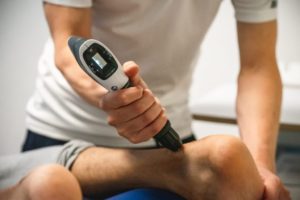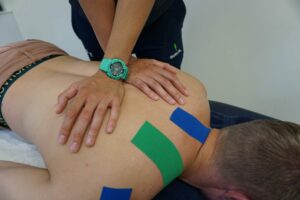Wat is een Slijmbeursontsteking?
Een slijmbeurs is een kleine met vloeistof gevulde zak die zich tussen botten, spieren, pezen en huid bevindt. Het heeft als doel wrijving te verminderen en bewegingen soepeler te laten verlopen. In de heup bevinden zich verschillende slijmbeurzen, waarvan de grootste zich aan de buitenzijde van de heup bevindt, tussen de grote dijbeenspier (gluteus maximus) en het bot van het dijbeen (trochanter major).
Bij overbelasting of irritatie kan de slijmbeurs ontstoken raken, wat leidt tot bursitis of slijmbeursontsteking. Deze ontsteking veroorzaakt pijn en kan het bewegen van de heup erg pijnlijk maken.
Symptomen van Slijmbeursontsteking in de Heup
Een slijmbeursontsteking in de heup kan een reeks symptomen veroorzaken. Enkele veelvoorkomende symptomen zijn:
- Pijn aan de buitenkant van de heup: De pijn kan aanvankelijk mild zijn, maar kan verergeren tijdens activiteiten zoals lopen, traplopen of langdurig zitten.
- Pijn tijdens liggen: Vooral bij het liggen op de aangedane heup kan er veel ongemak ontstaan.
- Stijfheid en zwelling: De heup kan stijf aanvoelen, en in sommige gevallen kan er zwelling zichtbaar zijn rond het pijnlijke gebied.
- Pijn bij beweging: Bewegingen waarbij de heup betrokken is, zoals het buigen en strekken van het been, kunnen pijn veroorzaken.
Oorzaken van Slijmbeursontsteking
Er zijn verschillende factoren die kunnen bijdragen aan het ontstaan van een slijmbeursontsteking in de heup. Deze zijn onder andere:
- Overbelasting: Herhaalde bewegingen of activiteiten zoals hardlopen, fietsen of traplopen kunnen de slijmbeurs irriteren.
- Verkeerde lichaamshouding: Een verkeerde houding of een afwijkend looppatroon kan zorgen voor extra druk op de heup, wat de slijmbeurs kan overbelasten.
- Trauma: Een val of stoot op de heup kan leiden tot een acute ontsteking van de slijmbeurs.
- Artrose: Mensen met heupartrose hebben een verhoogd risico op het ontwikkelen van bursitis, doordat de gewrichten extra belast worden.
- Slechte spierbalans: Zwakke of overbelaste spieren rond de heup kunnen extra druk op de slijmbeurs uitoefenen.
Behandeling van Slijmbeursontsteking
Bij Fysiotherapie Iburg bieden we een breed scala aan behandelingen om u te helpen herstellen van een slijmbeursontsteking in de heup. Onze fysiotherapeuten werken samen met u aan een persoonlijk behandelplan om de pijn te verlichten en mobiliteit te herstellen.
1. Oefentherapie
Zodra de acute pijn is verminderd, richten we ons op het herstellen van de mobiliteit en het versterken van de spieren rond de heup. Dit kan helpen om de druk op de slijmbeurs te verlagen en toekomstige klachten te voorkomen. Wij bieden specifieke oefeningen aan die gericht zijn op het verbeteren van de stabiliteit en flexibiliteit van de heupspieren.
2. Manuele Therapie
Onze therapeuten kunnen manuele technieken toepassen om gespannen spieren te ontspannen en de beweeglijkheid van de heup te verbeteren. Dit kan de pijn verlichten en ervoor zorgen dat u weer vrijer kunt bewegen.
3. Dry Needling
Bij aanwezigheid van spierspanning of triggerpoints kan dry needling een effectieve behandeling zijn. Deze techniek helpt om spierknopen te ontspannen en pijn te verminderen.
4. Houdingsadvies en Looptips
Omdat een verkeerde houding of looppatroon vaak bijdraagt aan slijmbeursontsteking, geven we bij Fysiotherapie Iburg advies over hoe u uw houding kunt verbeteren en de belasting op uw heup kunt verminderen tijdens dagelijkse activiteiten.
Maak een afspraak bij onze fysiotherapie
Als u meer wilt weten over hoe fysiotherapie u kan helpen bij last van slijmbeursontsteking in de heup, nodigen we u uit om contact met ons op te nemen.
Neem vandaag nog contact met ons op voor een afspraak of meer informatie. Neem de controle terug over uw gezondheid met de juiste ondersteuning en zorg.







